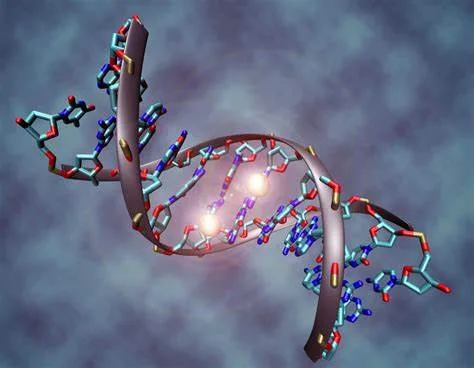Obesity is a worldwide problem affecting tons of people. It is a result of poor decisions like overeating as well as a lack of physical activity. However, experts are aware of the role of genetics as well as epigenetics in obesity’s development & progression. Nonetheless, we’ll delve into the complicated link between obesity, epigenetics, as well as gene regulation.

Understanding Obesity: More Than Just Excess Weight
Obesity Defined:
Obesity is a medical issue that is both complicated and multifaceted. It goes beyond merely having excess weight. It can be risky to one’s health and is characterized by an abnormal buildup of body fat. The Body Mass Index has limitations since it does not account for factors like muscle mass, bone density, or fat distribution, despite its usage in assessing obesity. Complex connections between the environment, genetics, and personal behavior lead to obesity. Genetics can influence how the body stores and burns fat. This can make several people more susceptible to obesity. In addition, environmental variables including sedentary lifestyles, high-calorie meals, and easy access to processed foods have a big role.
Beyond Calories In, Calories Out:
Unlike the simplified concept of “calories in, calories out,” which implies that weight growth is only governed by the balance between calories taken and burned. Obesity is influenced by relationships between psychological, physiological, as well as metabolic factors. In addition, emotional eating and psychological variables lead to poor eating patterns as well as weight gain. The obesity pandemic is made worse by the contemporary environment, which is characterized by little chances for physical activity, constant promotion of bad foods, and increasing screen time.

Epigenetics: The Hidden Influencer
Epigenetic Mechanisms
Histones are chemical changes that link to DNA and its related proteins and are at the center of epigenetic processes. These modifications include DNA methylation as well as histone acetylation. They increase or decrease gene expression. Researchers are discovering patterns that correspond with obesity as they delve into the epigenome. Furthermore, these patterns can be affected by numerous environmental variables such as nutrition, stress, and toxicity exposure. This dynamic interaction between genetics and environment ultimately shapes a person’s susceptibility to obesity.
Beyond Calories In, Calories Out
The conventional approach to weight control is based on the basic principle of calories in, calories out. The truth, on the other hand, is far more convoluted. Epigenetics reveals that genetic propensity to fat is not simply determined by the genes one inherits. Rather, environmental factors can modify gene expression. These variables increase the probability of obesity. A person with a genetic tendency to obesity might not become obese if they are exposed to a healthy environment. A person with an apparently favorable genetic profile might succumb to obesity if exposed to an obesogenic environment. An obesogenic environment comes with bad dietary choices as well as minimal physical activity.

Gene Regulation: Orchestrating the Obesity Symphony
A. Gene Expression Regulation
At the heart of every biological process lies the intricate dance of gene regulation. It’s where genes are turned on and off, defining an organism’s fate. Gene expression control is critical in orchestrating the symphony of metabolic pathways that affect body weight in the setting of obesity. Genes encode proteins. Additionally, these proteins dictate the functions and behaviors of cells. Through mechanisms like transcription factors, epigenetic modifications, and microRNAs, the body meticulously adjusts gene expression in response to various signals. These may create a delicate balance between energy intake, expenditure, as well as storage.
B. Genetic Predisposition to Obesity
Obesity has a hereditary basis that cannot be disregarded. Nonetheless, lifestyle variables such as nutrition and physical exercise play a substantial role. Certain genetic variants have been demonstrated in studies to predispose people to obesity. These genetic markers might influence appetite metabolism, regulation, as well as fat storage. For instance, FTO gene alterations have been linked to increased hunger and a greater risk of obesity. Genetic propensity, however, is not a deterministic element. As a result, it engages in intricate environmental interactions.
C. Interaction Between Genetics and Environment
The interaction between genetics and the environment forms a dynamic interplay that shapes an individual’s risk of obesity. An environment rich in high-calorie, processed foods can trigger genetically susceptible people to gain weight more easily. Conversely, individuals with a genetic predisposition might have a heightened response to healthier lifestyle interventions, showcasing the intricate dance between nature and nurture. The study of altered gene expression that does not include modifications to the DNA sequence itself is known as epigenetics. It adds another layer to this interaction. Environmental factors like diet during early life, can influence epigenetic marks that impact gene expression patterns. These potentially set the stage for obesity or protection against it.

Epigenetic Control of Obesity-Related Genes
A. DNA Methylation and Obesity:
DNA methylation is the addition of a methyl group to cytosine bases in DNA. It is a fundamental epigenetic mark that can stably modulate gene expression. Changes in DNA methylation patterns linked with appetite control, metabolism, as well as adipogenesis in obesity. Hypomethylation of particular genes involved in adipocyte development. This might result in increased fat accumulation. The PPAR gene is an important adipogenesis regulator. It undergoes dynamic DNA methylation changes that impact its expression in obese people. Additionally, DNA methylation changes in genes related to appetite control that involve leptin and ghrelin. They might contribute to disrupted hunger signaling in obesity.
B. Histone Modifications and Energy Homeostasis:
Histones are proteins around which DNA is wrapped, forming nucleosomes. Modifications to histones, like acetylation, methylation, and phosphorylation, can influence chromatin structure and thereby gene expression. Histone alterations influence energy balance in obesity by affecting genes involved in metabolism and energy expenditure. Increased histone acetylation in the promoter regions of genes like PPAR, for example, boosts their expression. It can promote fatty acid oxidation and energy utilization. Nonetheless, histone deacetylation in genes linked to gluconeogenesis & lipogenesis leads to boosted blood glucose levels as well as fat accumulation.
Research has unveiled interactions between DNA methylation as well as histone modifications in obesity-related gene regulation. These epigenetic marks are not independent but often crosstalk to establish gene expression patterns. Obesity-associated epigenetic changes can occur early in life due to prenatal and early postnatal exposures. These may underscore the developmental origins of obesity. Furthermore, environmental factors such as diet, physical activity, and stress can shape epigenetic modifications. These could make them potential targets for therapeutic interventions.
Lifestyle Factors and Epigenetic Impact
A. Early-Life Nutrition:
Mounting evidence suggests that early-life nutrition plays a pivotal role in shaping a person’s epigenetic landscape. The nourishment a fetus or infant receives can have enduring effects on gene expression patterns, impacting health outcomes later in life. Nutritional deficiencies or imbalances during critical developmental stages can lead to epigenetic modifications that increase the risk of chronic diseases. These involve diabetes, cardiovascular ailments, and even certain cancers. Maternal diets deficient in key nutrients could result in DNA methylation alterations. These might impact the expression of genes involved in metabolic activities. Nonetheless, breast milk quantity & quality linked to epigenetic modifications impact an infant’s susceptibility to obesity.
B. Obesogens and Environmental Influence:
Obesogens are environmental compounds that can disrupt normal metabolic processes. They also contribute to obesity by changing epigenetic regulation. These compounds include endocrine-disrupting chemicals found in plastics, pesticides, and some foods. Pregnancy obesogen exposure has been linked to epigenetic modifications that predispose children to obesity and metabolic problems. The impact of obesogens extends beyond direct exposure. Epigenetic changes can be inherited across generations. These environmental factors can modify DNA methylation patterns, histone modifications, as well as non-coding RNA expression. Nonetheless, they collectively affect the expression of genes involved in energy balance, adipogenesis, and appetite regulation.
The epigenetic effects of early-life nutrition and obesogens intertwine. These may create a complex network of interactions that influence health outcomes. Notably, these effects are not limited to physical health but can also influence cognitive and behavioral traits. Epigenetic modifications driven by these lifestyle factors are reversible to some extent. Additionally, these might offer hope for interventions that could mitigate the long-term consequences.
Therapeutic Implications and Future Directions
A. Targeting Epigenetic Modifications:
Recent studies have illuminated the potential of targeting epigenetic modifications as a novel therapeutic strategy for obesity management. DNA methylation is a prominent epigenetic mark. It is tightly linked to genes that are connected to obesity. Different DNA methylation patterns between fat and thin people have been discovered by researchers. Nevertheless, they suggest that these modifications contribute to altered gene expression underlying obesity. Manipulating DNA methylation through epigenetic editing tools holds promise in correcting the dysregulated gene expression linked to obesity. However, challenges remain in terms of the specificity and long-term safety of such interventions.
Histone modifications, another critical facet of epigenetics, influence the three-dimensional folding of chromatin and thus gene accessibility. Obesity-related metabolic dysregulation has been linked to aberrant histone changes. The development of tiny compounds that control histone acetylation or methylation may offer a focused method for resetting the gene expression patterns associated with obesity. Nevertheless, the intricate nature of histone modifications necessitates a deeper understanding of their role in obesity-associated pathways before effective therapies can be designed.
B. Personalized Approaches:
Various genetic, epigenetic, environmental, and behavioral elements all have a role in the diverse development of obesity. A person’s unique genetic and epigenetic composition is taken into account while creating personalized medication. It presents a promising avenue for obesity management. Integrating genomic and epigenomic information could enable the identification of people at higher risk of obesity, paving the way for early interventions.
Precision nutrition, an emerging field, seeks to optimize dietary recommendations based on a person’s genetic and epigenetic profile. Understanding how certain genes and epigenetic markers impact nutrition metabolism can help researchers create dietary programs that are more successful at treating and preventing obesity. To maximize the impact of physical activity in the battle against obesity, personalized exercise routines may be developed to take advantage of a person’s genetic makeup and epigenetic alterations.
Final Thoughts
A challenging puzzle involving the relationship between obesity, epigenetics, and gene regulation is being slowly but definitely resolved by experts. While a person’s inclination for obesity may be influenced by heredity, epigenetic modifications serve as a bridge between a person’s hereditary sensitivity and outside influences. Understanding how these factors interact holds promise for devising innovative strategies to combat the obesity epidemic. Moving towards a future where personalized interventions effectively address this complex health challenge.
Thank you for reading this post, don't forget to subscribe to our free newsletter
!